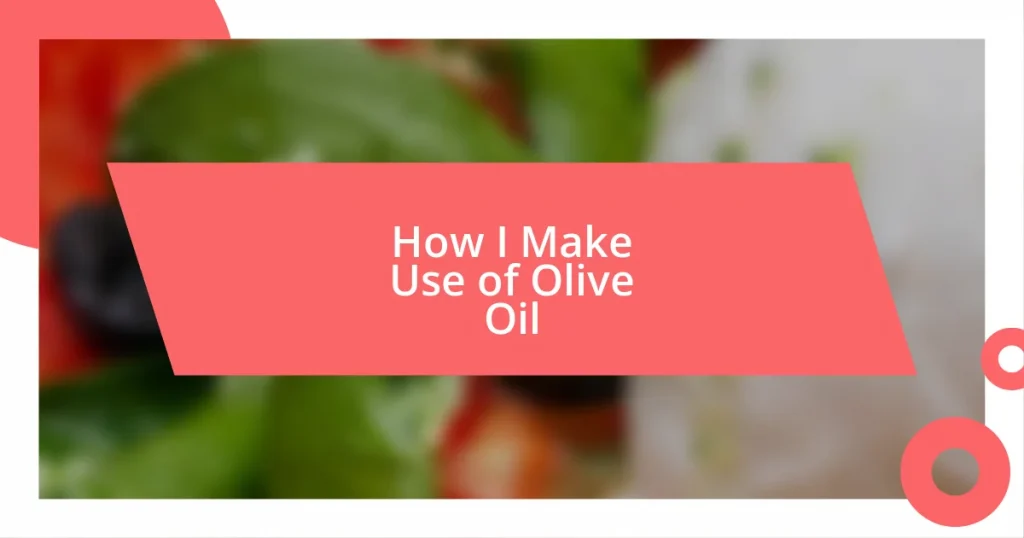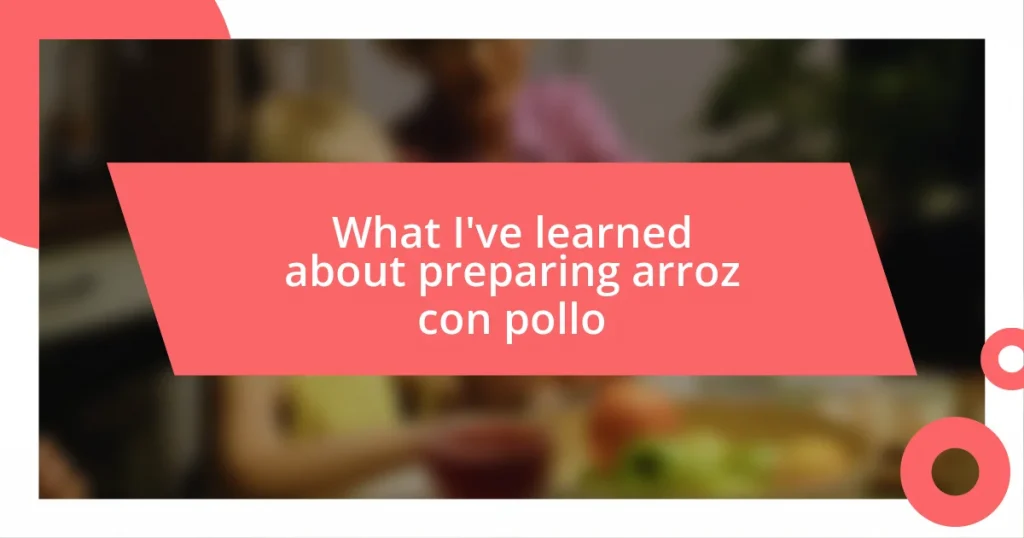Key takeaways:
- Incorporating olive oil into meals boosts flavor and supports cardiovascular health due to its antioxidants and healthy fats.
- Choosing high-quality olive oil is essential for maximizing both taste and health benefits, with factors like extra virgin grade, harvest date, and packaging being important considerations.
- Olive oil can be creatively used in cooking, dressing, skincare, and even desserts, demonstrating its versatility and enhancing both flavor and wellness.
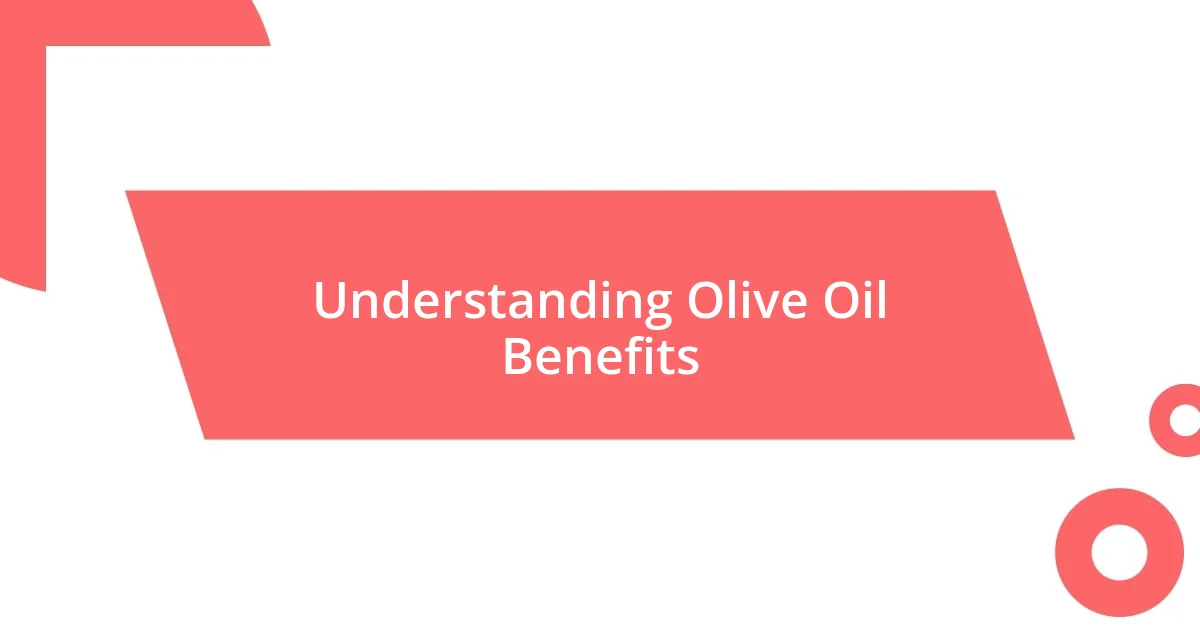
Understanding Olive Oil Benefits
When I first started incorporating olive oil into my meals, I was blown away by the rich flavor it added—not just to my salads, but to everyday cooking too. Beyond taste, I quickly learned about its health benefits, particularly its heart-healthy fats. Have you ever considered how a simple drizzle of olive oil can not only elevate your dish but also support your cardiovascular health?
One of the standout benefits of olive oil is its potent antioxidants, like vitamin E, which can help combat oxidative stress in our bodies. I remember reading about a study showing that regular consumption of olive oil can reduce the risk of chronic diseases. It made me reflect on my own cooking habits. Swapping out other fats for olive oil felt like an easy, impactful change.
Another aspect that really struck me is how olive oil can enhance nutrient absorption in foods. For instance, when I make a spinach salad and add olive oil, I notice that I feel more energized afterward. It’s fascinating to think about how a small addition like this can maximize the nutritional value of our meals. Have you ever felt a difference after making minor changes to your diet? I certainly have!
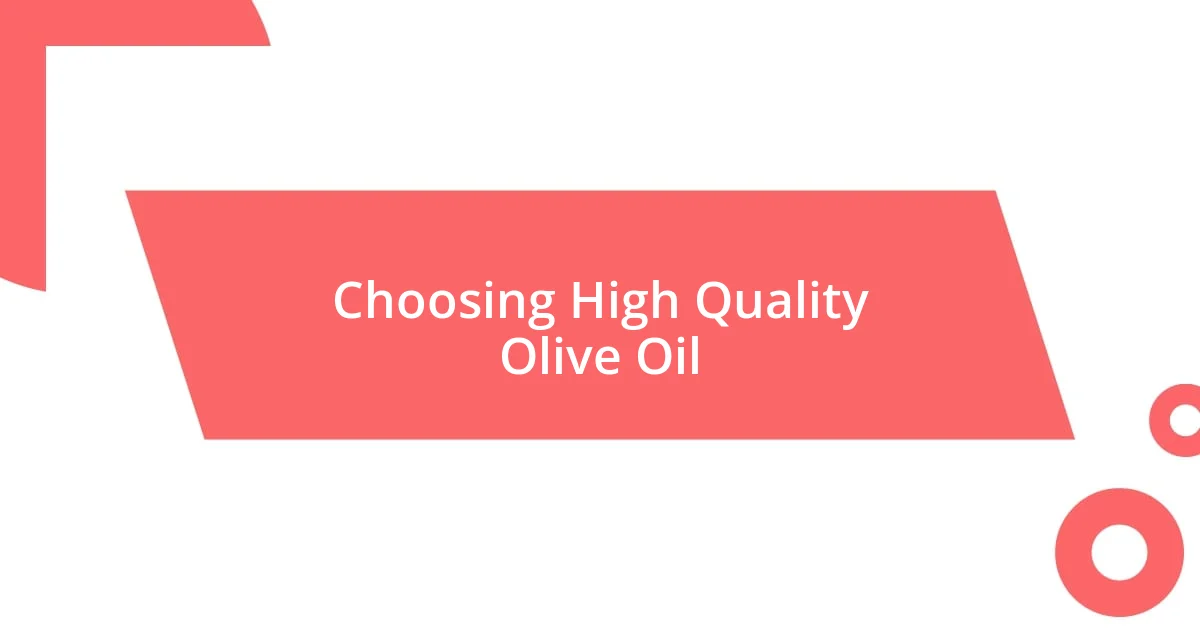
Choosing High Quality Olive Oil
Choosing high-quality olive oil can significantly impact both flavor and health benefits. Personally, I’ve found that a robust, full-bodied oil adds a depth of flavor that lighter oils simply can’t match. When I started selecting oils, I paid close attention to things like the harvest date and origin. It might seem trivial, but knowing when the olives were pressed can tell you a lot about the oil’s freshness and flavor profile.
To help you on your journey to finding the best olive oil, here are some key factors to consider:
- Extra Virgin Grade: Always opt for extra virgin olive oil. It’s the highest quality with the best flavor and health benefits.
- Harvest Date: Look for oils that have a clear harvest or bottling date. Freshness is crucial for flavor and nutrients.
- Dark Glass Bottles: Quality olive oils are often sold in dark bottles to protect them from light, which can degrade the oil.
- Certification Labels: Seek out oils that have certifications, like PDO (Protected Designation of Origin) or PGI (Protected Geographical Indication), ensuring authenticity and quality.
- Taste Test: Don’t be shy! A tasting can reveal a world of flavors—from fruity and peppery to smooth and grassy.
Finding the right olive oil has become a delightful adventure in my kitchen, enhancing my dishes and making cooking feel special. It’s a small step that transforms my meals—and I think anyone can experience that same joy!
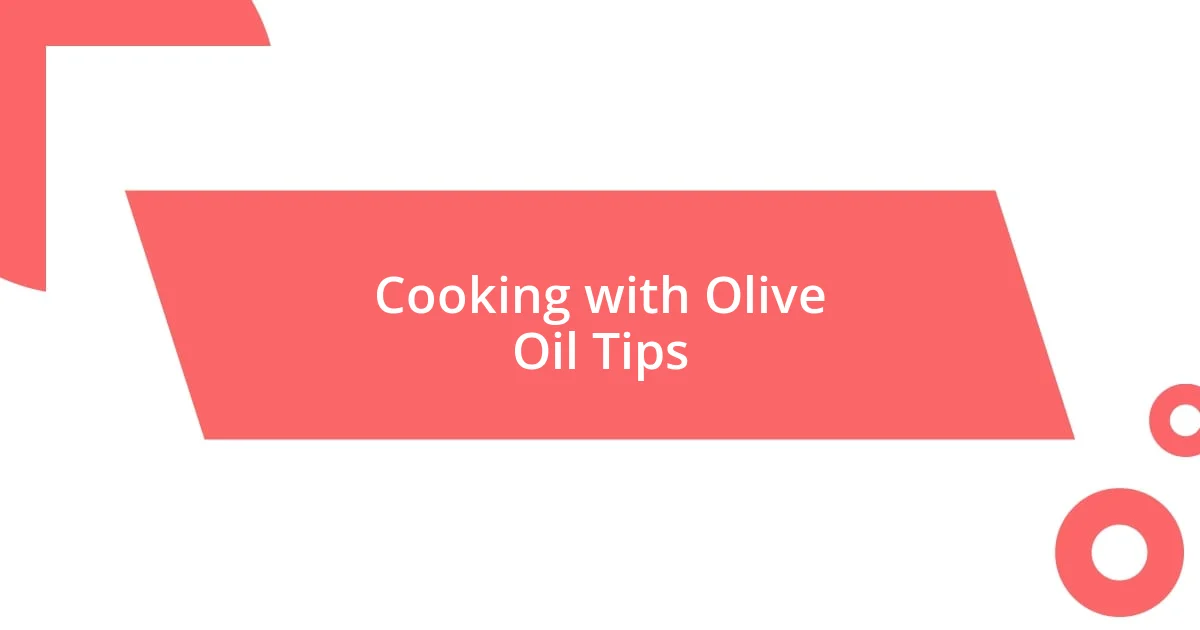
Cooking with Olive Oil Tips
Cooking with olive oil is an art I’ve come to appreciate deeply. One of the best tips I can share is to remember that not all olive oils are created equal; each has unique flavors that can enhance various dishes. For instance, I love using a fruity olive oil when preparing a Mediterranean pasta dish—it brightens everything up. On the other hand, a more peppery oil can really complement grilled vegetables, bringing out their natural flavors beautifully.
Another critical point is the cooking temperatures. Extra virgin olive oil has a smoke point of about 375°F (190°C), which makes it ideal for sautéing and roasting but not for deep frying. I once made that mistake myself—I tried frying potatoes in extra virgin olive oil, and the smoke nearly set off my fire alarm! Since then, I’ve learned to save my premium olive oils for finishing touches, where they can shine without losing their quality.
Lastly, don’t underestimate the power of pairing. Drizzling a fruity olive oil over fresh bread or using it as a dip can turn a simple appetizer into something extraordinary. I always keep a small dish of olive oil and balsamic vinegar on the table. It sparks conversations and invites my friends and family to try different combinations. Have you ever experimented with olive oil in unexpected ways? It’s a game changer!
| Tip | Details |
|---|---|
| Flavor Profiles | Choose oil based on the dish: fruity for pasta, peppery for grilling. |
| Cooking Temperatures | Extra virgin olive oil is best for sautéing and drizzling, not for frying. |
| Pairing Ideas | Use olive oil as a dip with bread for an elevated appetizer. |
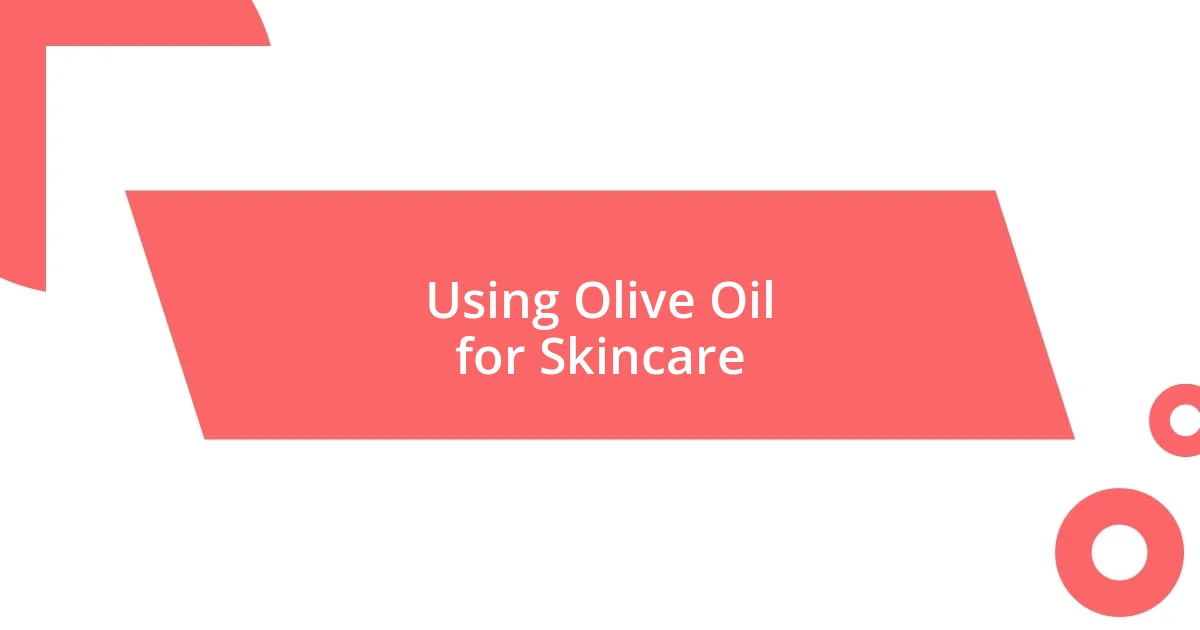
Using Olive Oil for Skincare
I’ve discovered that using olive oil for skincare can be a game-changer for maintaining hydration and glow. I remember the first time I applied a few drops to my dry skin after a long day outdoors; the instant relief was incredible. It’s almost like my skin sighed in gratitude, embracing the nourishment and softness immediately.
What I love most is that olive oil is rich in antioxidants and healthy fats, which help to combat aging and nourish the skin. A simple olive oil massage on a rough patch or even as a makeup remover gives me that satisfying feeling of pampering myself. Have you ever used it as a lip balm? I did once on a windy day, and my chapped lips transformed back into softness after just a few swipes.
I’ve also experimented with creating my own exfoliating scrub by mixing olive oil with brown sugar. The experience was not only therapeutic but left my skin feeling rejuvenated and smooth. It makes me wonder—how many little beauty secrets are hiding just within my pantry? Using olive oil has truly made my skincare routine feel special and indulgent, showing that sometimes, the best solutions are the simplest ones.
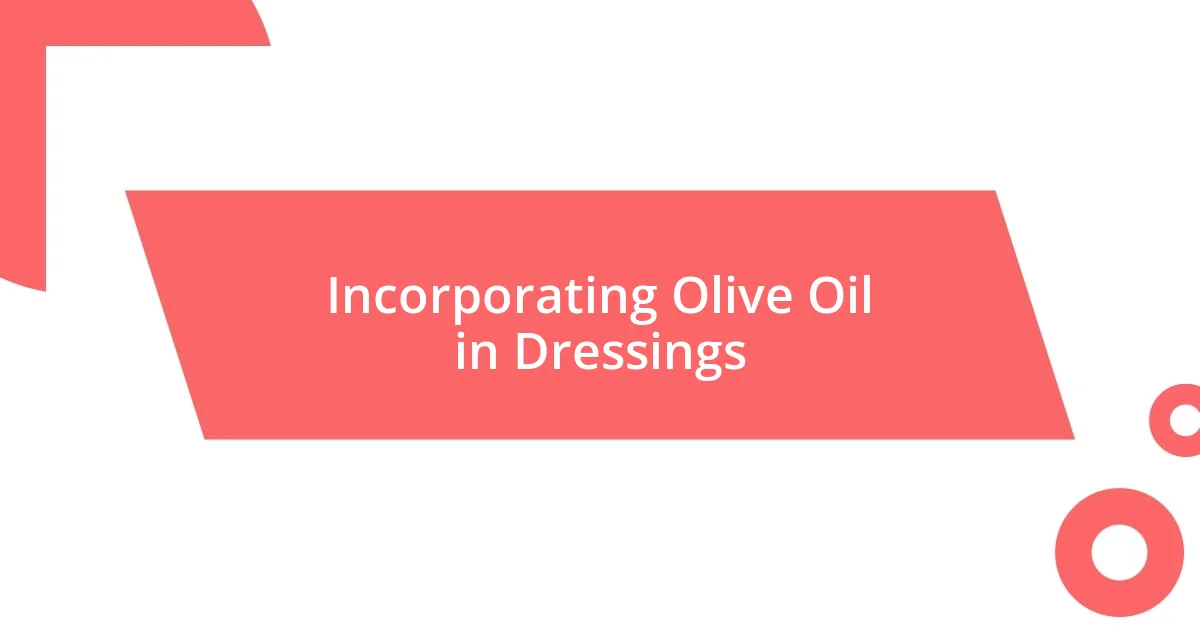
Incorporating Olive Oil in Dressings
When I whip up salad dressings, olive oil is my go-to ingredient. I can still remember the first time I made a simple vinaigrette—just olive oil, vinegar, and a hint of mustard. The moment I tasted it, I realized how the oil acted as a luscious base, enhancing the other flavors and elevating the entire dish.
I particularly enjoy crafting dressings with complementary flavors in mind. For instance, a rich, peppery oil pairs beautifully with balsamic vinegar, creating a savory, tangy kick that transforms an ordinary salad into something memorable. Have you ever experimented with flavored olive oils? A garlic-infused oil can add an irresistible depth to your dressing that makes every bite delightful.
One of my favorite quick tricks is to add fresh herbs to my olive oil dressings. A sprig of rosemary or a handful of basil not only brightens the oil but also invites a fresh aroma that makes my kitchen feel alive! It’s like giving the dressing a personality—a burst of color and flavor that invites everyone to dig in. It truly makes me appreciate the nuances that olive oil brings, don’t you agree?
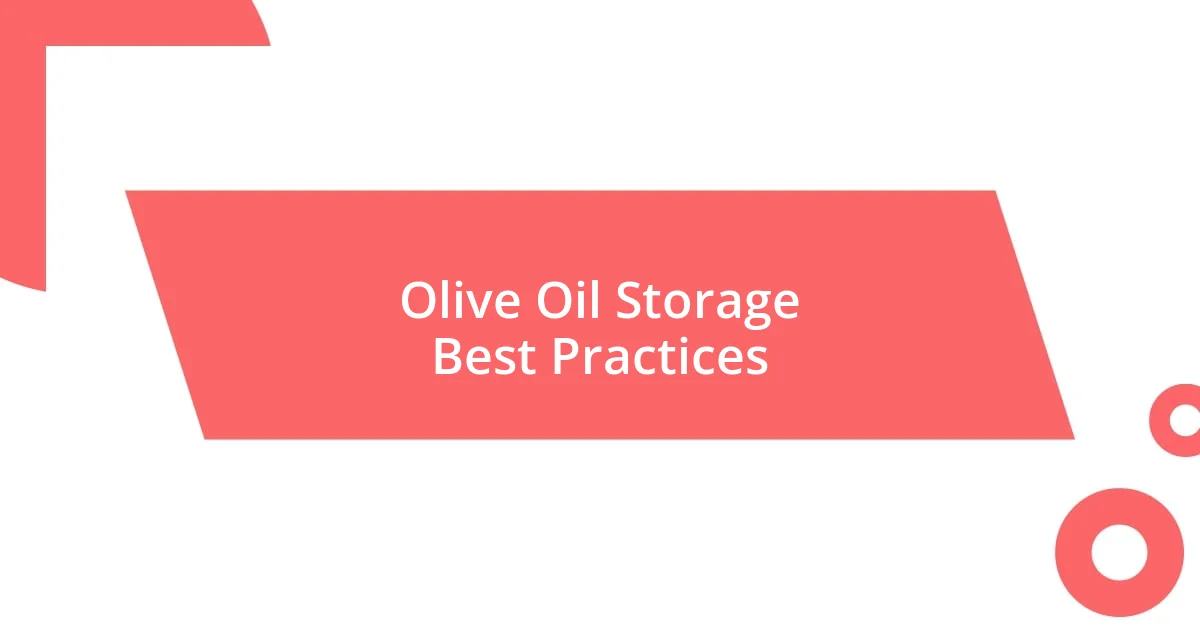
Olive Oil Storage Best Practices
When it comes to storing olive oil, I’ve learned that keeping it away from heat and light is crucial. I always choose a dark glass bottle, as it protects the oil from sunlight, which can degrade its quality over time. I remember once leaving a bottle on the countertop near the stove; it quickly became rancid, and I regretted that oversight.
I also find that a cool, consistent temperature makes a significant difference. Your pantry is usually the best spot, but I also have a little corner of my kitchen that stays nice and cool. Have you ever thought about how temperature fluctuations can affect flavor? The other day, I moved a bottle I loved to a warmer area, and I could swear it lost some of that rich, fruity taste that originally drew me to it.
Lastly, I try to use olive oil within six months of opening. It’s easy to forget, but I always mark the date on the bottle, so I know when it’s time to replace it. The rich aroma and vibrant flavor are what I cherish most; after all, why let those qualities fade away? Have you ever tasted fresh oil versus an old one? The difference is remarkable, and it reminds me to always enjoy it at its best.
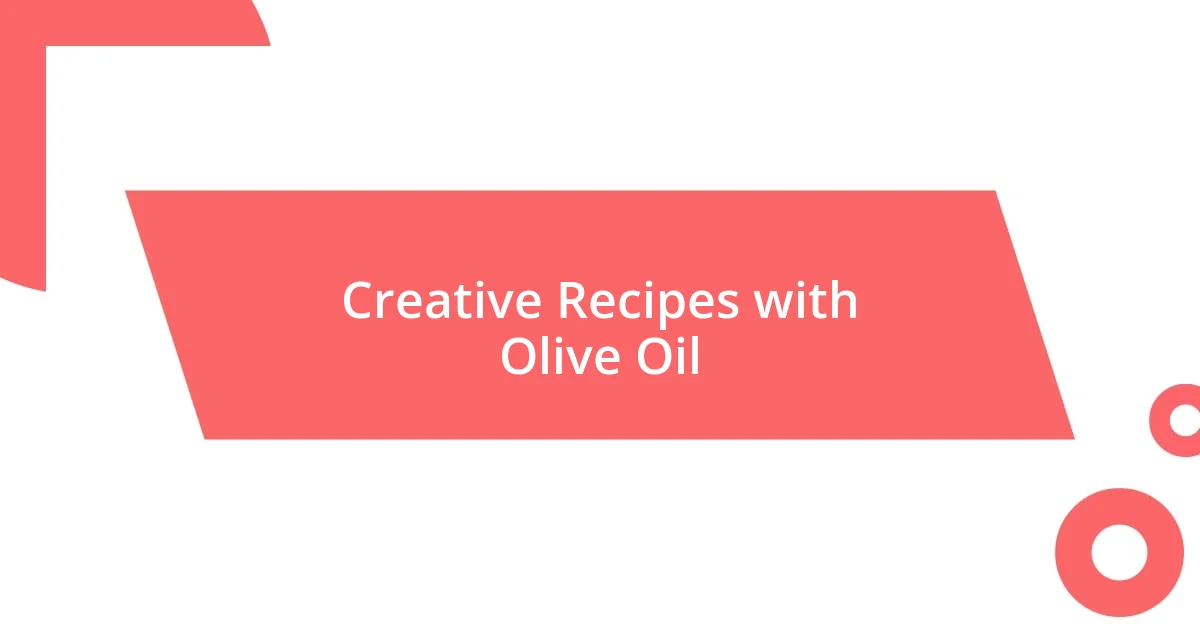
Creative Recipes with Olive Oil
I love experimenting with olive oil in my cooking, especially when making a simple pasta dish. Recently, I drizzled a generous amount of high-quality olive oil over freshly cooked spaghetti, adding grated parmesan and a sprinkle of cracked black pepper. The way the oil clung to the pasta, creating a silky texture, was nothing short of magic. Have you ever found that a splash of olive oil can turn a plain meal into a culinary masterpiece?
One of my go-to creative recipes involves roasted vegetables. I chop up a medley of seasonal produce, like zucchini, bell peppers, and carrots, and toss them generously with olive oil, garlic, and herbs. Roasting them in the oven allows the oil to caramelize the vegetables, releasing such a rich, savory aroma—it’s simply irresistible! I often find myself sneaking bites right off the baking sheet. Doesn’t that kind of comfort food make you feel at home?
Desserts are another surprising area where I love to use olive oil. The last time I made chocolate chip cookies, I swapped out some of the butter for olive oil, and it was a revelation. Not only did the cookies turn out soft and chewy, but there was this subtle, fruity undertone that made them unique. I still remember the look on my friends’ faces when they took the first bite—they were blown away! Who would’ve thought olive oil could enhance a sweet treat like that?










